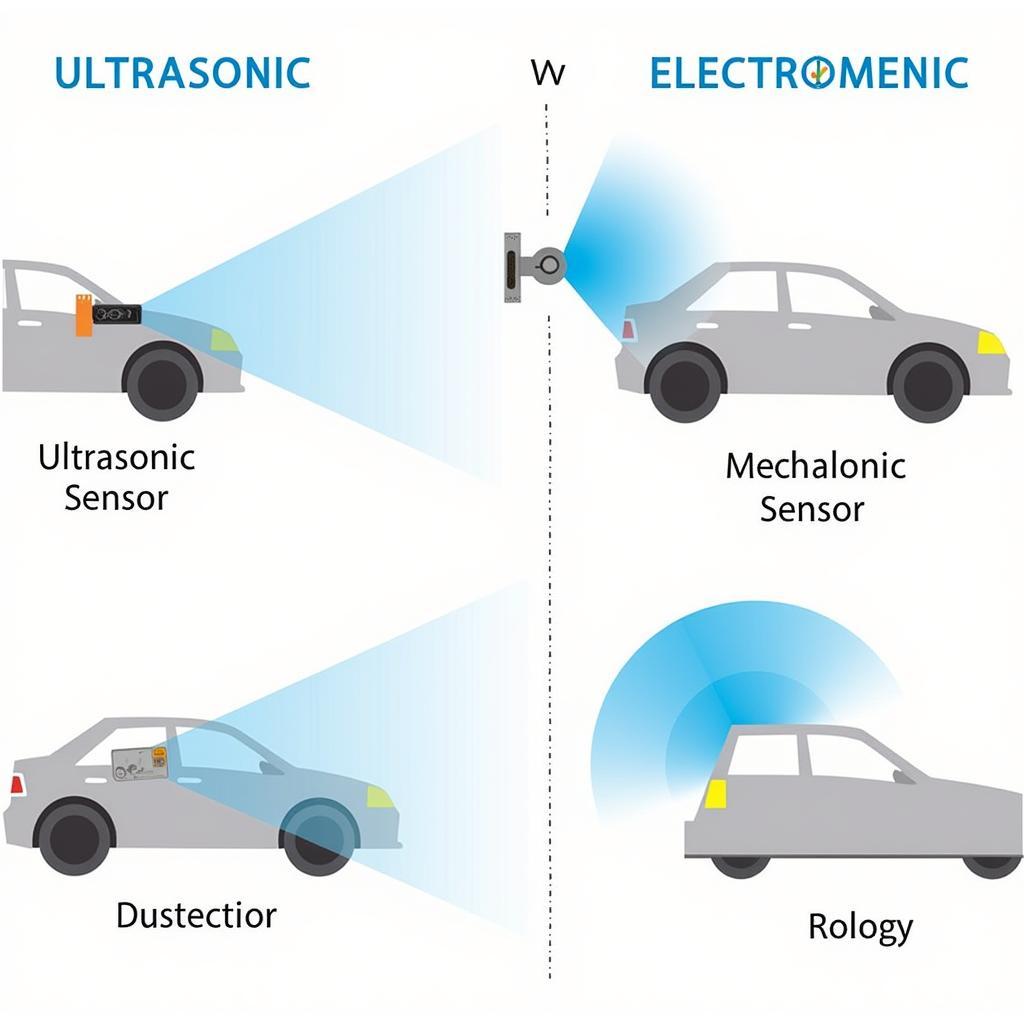A malfunctioning car proximity sensor can be a real headache. Whether you’re trying to park in a tight spot or simply want to avoid bumping into objects, a faulty sensor can make driving more stressful. This comprehensive guide will help you understand, diagnose, and potentially fix your car’s proximity sensor problem.
Have you ever experienced the frustration of your car’s proximity sensor going haywire? It’s a common issue, and understanding the root cause is the first step to getting it fixed. From faulty wiring to environmental interference, there are a number of reasons why your car’s proximity sensors might be acting up. This article will delve into the common causes, diagnostic procedures, and potential solutions for car proximity sensor problems.
You might want to check out common smart car door problems, which can sometimes be related to proximity sensor issues. smart car door problems
Understanding Car Proximity Sensors
Proximity sensors are the unsung heroes of modern parking. These small electronic devices use ultrasonic waves or electromagnetic fields to detect objects near your vehicle. They then relay this information to your car’s computer, which triggers an audible warning or visual alert on your dashboard. Understanding how these sensors work is key to troubleshooting any issues.
Types of Proximity Sensors
There are two main types of proximity sensors used in cars: ultrasonic and electromagnetic. Ultrasonic sensors emit high-frequency sound waves that bounce off nearby objects. The sensor then measures the time it takes for the echo to return, calculating the distance to the object. Electromagnetic sensors, on the other hand, use changes in the magnetic field to detect nearby metallic objects.
 Car Proximity Sensor Types: Ultrasonic and Electromagnetic
Car Proximity Sensor Types: Ultrasonic and Electromagnetic
Common Causes of Car’s Proximity Sensor Problems
Several factors can contribute to a car’s proximity sensor problem. These include environmental factors like heavy rain or snow, which can interfere with the sensor’s ability to detect objects accurately. Physical damage to the sensor itself, such as a cracked lens or a misaligned sensor, can also cause problems. Electrical issues, such as faulty wiring or a blown fuse, are another common culprit.
Diagnosing the Issue
Diagnosing a car’s proximity sensor problem requires a systematic approach. Start by visually inspecting the sensors for any signs of physical damage. Check for dirt, debris, or ice buildup that might be obstructing the sensor’s view. Next, listen for any unusual clicking sounds coming from the sensors when they are active. This can indicate a problem with the sensor’s internal components.
 Diagnosing Car Proximity Sensor Issues: Visual Inspection
Diagnosing Car Proximity Sensor Issues: Visual Inspection
How to Fix a Car’s Proximity Sensor Problem
Depending on the cause of the problem, there are several ways to fix a car’s proximity sensor problem. If the sensor is simply dirty or obstructed, cleaning it with a soft cloth and some mild detergent may be all that’s needed. If the sensor is damaged, it will likely need to be replaced. Electrical issues will require more in-depth troubleshooting, potentially involving checking the wiring harness and replacing any faulty components.
“Regular maintenance is key to preventing proximity sensor issues,” advises John Smith, Senior Automotive Engineer at Autotippro. “A simple cleaning can often prevent more serious problems down the line.”
DIY Fixes vs. Professional Help
Some proximity sensor problems can be easily fixed at home with basic tools and a little know-how. However, more complex issues, particularly those involving electrical systems, are best left to qualified professionals.
If you are unsure about tackling the repair yourself, it’s always best to err on the side of caution and seek professional help. Contact us at Autotippro, +1 (641) 206-8880, or visit our office at 500 N St Mary’s St, San Antonio, TX 78205, United States.
Conclusion
A car’s proximity sensor problem can be frustrating, but with the right information and approach, it can be effectively diagnosed and resolved. Remember, regular maintenance and prompt attention to any warning signs can help prevent more serious problems down the road.
Need help with your car’s door? You may find this article helpful: smart car door problems
Contact Autotippro at +1 (641) 206-8880 or visit our office at 500 N St Mary’s St, San Antonio, TX 78205, United States for expert assistance with your car’s proximity sensor problem.
“Remember, addressing proximity sensor problems promptly ensures safer driving and prevents potential accidents,” adds Jane Doe, Lead Technician at AutoTipPro.
FAQ
- How often should I clean my car’s proximity sensors?
- Can I use any cleaning product on my proximity sensors?
- What does it mean when my proximity sensor beeps continuously?
- How much does it cost to replace a car proximity sensor?
- Can I disable my car’s proximity sensors?
- How do I know if my car has electromagnetic or ultrasonic sensors?
- What should I do if my proximity sensor warning light stays on?




Leave a Reply